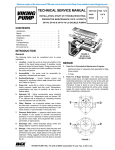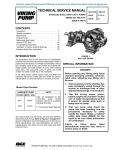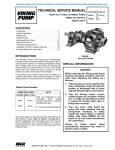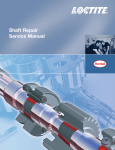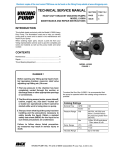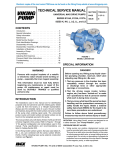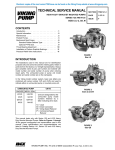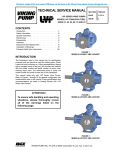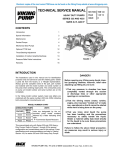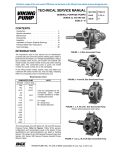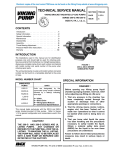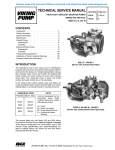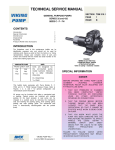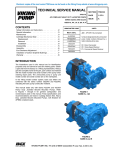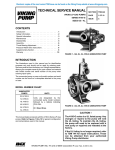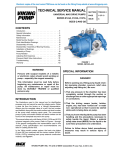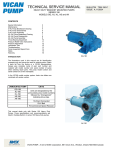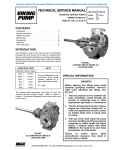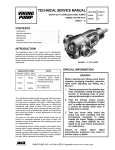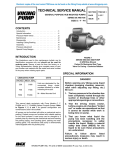Download PDF
Transcript
Electronic copies of the most current TSM issue can be found on the Viking Pump website at www.vikingpump.com TECHNICAL SERVICE MANUAL UNIVERSAL 682 HEAVY DUTY JACKETED PUMPS SERIES 4223AA AND 4323AA SECTION TSM 632 PAGE 1 OF 9 ISSUE A SIZES H, HL, K, KK, LQ, LL, LS, Q, QS, N, R, RS CONTENTS Safety Information and Instructions . . . . . . . . . . . 3 Special Information . . . . . . . . . . . . . . . . . . . .3 Maintenance . . . . . . . . . . . . . . . . . . . . . . .3 Cartridge Mechanical Seal . . . . . . . . . . . . . . . .4 Replacement . . . . . . . . . . . . . . . . . . . . . .4 Removal . . . . . . . . . . . . . . . . . . . . . . . .4 Installation . . . . . . . . . . . . . . . . . . . . . . .5 Disassembly . . . . . . . . . . . . . . . . . . . . . . .5 Assembly . . . . . . . . . . . . . . . . . . . . . . . . .6 End Clearance Adjustment . . . . . . . . . . . . . . . .7 Installation of Carbon Graphite Bushings . . . . . . . . 7 Pressure Relief Valve Instructions . . . . . . . . . . . .8 Warranty . . . . . . . . . . . . . . . . . . . . . . . . .9 INTRODUCTION The illustrations used in this manual are for identification purposes only and cannot be used for ordering parts. Obtain a parts list from the factory or a Viking representative. Always give the complete name of the part, part number and material with the model number and serial number of the pump when ordering repair parts. The unmounted pump or pump unit model number and serial number are on the nameplate. UNMOUNTED PUMP MECH. SEAL H4223AA HL4223AA K4223AA KK4223AA LQ4223AA LL4223AA LS4223AA UNITS AA = Universal Seal Pump with API-682 Seal Units are designated by the unmounted pump model numbers followed by a letter indicating drive style. D = Direct Connected R = Viking Speed Reducer P = Commercial Speed Reducer Q4223AA QS4223AA N4323AA R4323AA RS4323AA In the Viking model number system, basic size letters are combined with the series number (4223AA and 4323AA) indicating the basic pump construction material. This manual deals only with Series 4223AA and 4323AA Heavy Duty Jacketed Bracket Mounted Pumps. Refer to Figures 1 through 8 for general configuration and nomenclature used in this manual. Pump specifications and recommendations are listed in Catalog Section 632, Universal 682, Heavy Duty Jacketed Pumps. FIGURE 1 SIZES H - QS FIGURE 2 SIZES N - RS VIKING PUMP, INC. • A Unit of IDEX Corporation • Cedar Falls, IA 50613 USA SAFETY INFORMATION AND INSTRUCTIONS IMPROPER INSTALLATION, OPERATION OR MAINTENANCE OF PUMP MAY CAUSE SERIOUS INJURY OR DEATH AND/OR RESULT IN DAMAGE TO PUMP AND/OR OTHER EQUIPMENT. VIKING’S WARRANTY DOES NOT COVER FAILURE DUE TO IMPROPER INSTALLATION, OPERATION OR MAINTENANCE. THIS INFORMATION MUST BE FULLY READ BEFORE BEGINNING INSTALLATION, OPERATION OR MAINTENANCE OF PUMP AND MUST BE KEPT WITH PUMP. PUMP MUST BE INSTALLED, OPERATED AND MAINTAINED ONLY BY SUITABLY TRAINED AND QUALIFIED PERSONS. THE FOLLOWING SAFETY INSTRUCTIONS MUST BE FOLLOWED AND ADHERED TO AT ALL TIMES. Symbol Legend : ! ! Danger - Failure to follow the indicated instruction may result in serious injury or death. BEFORE opening any liquid chamber (pumping chamber, reservoir, relief valve adjusting cap fitting, etc.) be sure that : ● Any pressure in the chamber has been completely vented through the suction or discharge lines or other appropriate openings or connections. ● The pump drive system means (motor, turbine, engine, etc.) has been “locked out” or otherwise been made non-operational so that it cannot be started while work is being done on the pump. WARNING WARNING ! WARNING ● You know what material the pump has been handling, have obtained a material safety data sheet (MSDS) for the material, and understand and follow all precautions appropriate for the safe handling of the material. ! ! ! ! WARNING ! WARNING BEFORE operating the pump, be sure all drive guards are in place. DO NOT operate pump if the suction or discharge piping is not connected. ! ! DO NOT place fingers into the pumping chamber or its connection ports or into any part of the drive train if there is any possibility of the pump shafts being rotated. DO NOT exceed the pumps rated pressure, speed, and temperature, or change the system/duty parameters from those the pump was originally supplied, without confirming its suitability for the new service. ! WARNING BEFORE operating the pump, be sure that: ● It is clean and free from debris ● all valves in the suction and discharge pipelines are fully opened. ● All piping connected to the pump is fully supported and correctly aligned with the pump. ● Pump rotation is correct for the desired direction of flow. ! WARNING SECTION TSM 632 ISSUE A PAGE 2 OF 9 Warning - In addition to possible serious injury or death, failure to follow the indicated instruction may cause damage to pump and/or other equipment. INSTALL pressure gauges/sensors next to the pump suction and discharge connections to monitor pressures. USE extreme caution when lifting the pump. Suitable lifting devices should be used when appropriate. Lifting eyes installed on the pump must be used only to lift the pump, not the pump with drive and/or base plate. If the pump is mounted on a base plate, the base plate must be used for all lifting purposes. If slings are used for lifting, they must be safely and securely attached. For weight of the pump alone (which does not include the drive and/or base plate) refer to the Viking Pump product catalog. DO NOT attempt to dismantle a pressure relief valve that has not had the spring pressure relieved or is mounted on a pump that is operating. AVOID contact with hot areas of the pump and/or drive. Certain operating conditions, temperature control devices (jackets, heat-tracing, etc.), improper installation, improper operation, and improper maintenance can all cause high temperatures on the pump and/or drive. THE PUMP must be provided with pressure protection. This may be provided through a relief valve mounted directly on the pump, an in-line pressure relief valve, a torque limiting device, or a rupture disk. If pump rotation may be reversed during operation, pressure protection must be provided on both sides of pump. Relief valve adjusting screw caps must always point towards suction side of the pump. If pump rotation is reversed, position of the relief valve must be changed. Pressure relief valves cannot be used to control pump flow or regulate discharge pressure. For additional information, refer to Viking Pump’s Technical Service Manual TSM 000 and Engineering Service Bulletin ESB-31. THE PUMP must be installed in a manner that allows safe access for routine maintenance and for inspection during operation to check for leakage and monitor pump operation. SPECIAL INFORMATION DANGER ! Before opening any Viking pump liquid chamber (pumping chamber, reservoir, relief valve adjusting cap fitting, etc.) Be sure: 1.That any pressure in the chamber has been completely vented through the suction or discharge lines or other appropriate openings or connections. 2.That the driving means (motor, turbine, engine, etc.) has been “locked out” or made nonoperational so that it cannot be started while work is being done on pump. 3. That you know what liquid the pump has been handling and the precautions necessary to safely handle the liquid. Obtain a material safety data sheet (MSDS) for the liquid to be sure these precautions are understood. Failure to follow above listed precautionary measures may result in serious injury or death. ROTATION: Viking pumps operate equally well in a clockwise or counterclockwise rotation. Shaft rotation determines which port is suction and which is discharge. Port in area where pumping elements (gear teeth) come out of mesh is suction port. PRESSURE RELIEF VALVES: 1. Viking pumps are positive displacement pumps and must be provided with some sort of pressure protection. This may be a relief valve mounted directly on the pump, an inline pressure relief valve, a torque limiting device or a rupture disk. 2. There are relief valve options available on those pump models designed to accept a relief valve. Options may include a return to tank relief valve and a jacketed relief valve. Pumps equipped with a jacketed head plate are generally not available with a relief valve. 3. If pump rotation is reversed during operation, pressure protection must be provided on both sides of pump. 4. Relief valve adjusting screw cap must always point towards suction side of pump. If pump rotation is reversed, remove pressure relief valve and turn end for end. 5. Pressure relief valves cannot be used to control pump flow or regulate discharge pressure. For additional information on pressure relief valves, Refer to Technical Service Manual TSM000 and Engineering Service Bulletin ESB-31. Jacketing of the bracket and head provide large chambers at both ends of the pumping chamber and around the stuffing box for temperature control of the product in the pump. Check the pump to be sure it is heated to operating temperature prior to startup. MECHANICAL SEALS: Extra care should be taken in repair of these pumps. Be sure to read and follow all special instructions supplied with your pump. MAINTENANCE Series 4223AA and 4323AA pumps are designed for long, trouble-free service life under a wide variety of application conditions with a minimum of maintenance. The points listed below will help provide long service life. LUBRICATION: Grease all grease fittings every 2000 hours of operation. If service is severe, grease more often. Grease must be applied slowly with a hand gun until the grease exiting the lip seal or relief plug is similar in consistency and color to the new grease. Use a NLGI #2 polyurea base grease for normal applications. For hot or cold applications, use appropriate grease. Consult factory with specific lubrication questions. CLEANING PUMP: Keep pump as clean as possible. This will facilitate inspection, adjustment and repair work and help prevent overlooking a dirt covered grease fitting. LIFTING: There is a lift eye on the bracket behind the casing for H-QS size pumps. This is intended for the pump only, not the entire unit. STORAGE: If pump is to be stored, or not used for six months or more, pump must be drained and a light coat of light oil must be applied to all internal pump parts. Lubricate fittings and apply grease to pump shaft extension. Viking suggests rotating pump shaft by hand one complete revolution every 30 days to circulate the oil. Tighten all pump assembly bolts before putting pump in service after being stored. SUGGESTED REPAIR TOOLS: The following tools must be available to properly repair series 4223AA and 4323AA pumps. These tools are in addition to standard mechanics’ tools such as open-end wrenches, pliers, screwdrivers, etc. Most of the items can be obtained from an industrial supply house. 1. Soft Headed Hammer 2. Allen wrenches 3. See TR-813 for locknut tools. Commercially available adjustable hook spanner wrenches are available for locknut removal, below. Sources: #471 J. H. Williams & Co. or equal for H-KK sizes #472 J. H. Williams & Co. or equal for LQ-QS sizes #474 J. H. Williams & Co. or equal for N size #474A J. H. Williams & Co. or equal for R-RS sizes 4. Spanner wrench, adjustable face spanner pin type for use on bearing housing endcap Sources: #482 J. H. Williams & Co. or equal for H-LS sizes #483 J. H. Williams & Co. or equal for Q- RS sizes 5. Brass or plastic bar 6. Arbor press SECTION TSM 632 ISSUE A PAGE 3 OF 9 EXPLODED VIEW PARTS FOR SERIES 4223AA MODELS EXPLODED VIEW PARTS FOR SERIES 4323AA MODELS ITEM NAME OF PART ITEM NAME OF PART ITEM ITEM NAME OF PART Pipe Plug 45 Relief Valve Gaskets (Optional) 31 Casing (Flanged) 46 Capscrews for Valve (Optional) Cartridge Seal 35 Head Gasket 47 Internal Relief Valve (Optional) Bracket Bushing 36 Rotor and Shaft Assembly 50 Lockwashers 27 Bracket and Bushing Assembly 37 Idler and Bushing Assembly 28 Capscrew/Studs for Bracket 38 Idler Bushing 51 Studs for Flanges 28A Nuts for Bracket 39 Idler Pin 52 Nuts for Flanges 29 Bracket Gasket 40 Head and Idler Pin Assembly 62 Rectangular Key for Shaft 30 Pipe Plug 43 Capscrew/Studs for Head 64 Guard 30B Pipe Plug 44 Nuts for Head 1 Locknut 16 Seal Nuts 30C 2 Lockwasher 17 Seal Studs 3 End Cap 19 4 Bearing Spacer Collar (Outer) 25 5 Lip Seals 6 Tapered Roller Bearings 7 Bearing Housing 8 Bearing Spacer Collar (Inner) (H-QS) 11 Rings, Half Round (K-LS) 12 Grease Fitting NAME OF PART 50A Washers EXPLODED VIEW PARTS FOR SERIES 4223AA AND 4323AA MODELS DANGER ! Before opening any Viking pump liquid chamber (pumping chamber, reservoir, relief valve adjusting cap fitting, etc.) Be sure: 1.That any pressure in the chamber has been completely vented through the suction or discharge lines or other appropriate openings or connections. 2.That the driving means (motor, turbine, engine, etc.) has been “locked out” or made nonoperational so that it cannot be started while work is being done on pump. 3. That you know what liquid the pump has been handling and the precautions necessary to safely handle the liquid. Obtain a material safety data sheet (MSDS) for the liquid to be sure these precautions are understood. Failure to follow above listed precautionary measures may result in serious injury or death. SECTION TSM 632 ISSUE A PAGE 4 OF 9 CARTRIDGE MECHANICAL SEAL REPLACEMENT MODELS: H, HL, K, KK, LQ, LL, LS, Q, QS 4223AA Steel N, R, RS 4323AA Steel For complete pump disassembly and assembly see pages 5 - 7. CARTRIDGE MECHANICAL SEAL REMOVAL 1. Insert brass or plastic bar into one of the pump ports and into the space between rotor teeth to prevent rotor and shaft from spinning. If removing the seal while pump is installed, lock shaft to prevent spinning. Bend up tang of lockwasher (Item 2) with flat bladed screw driver or small flat punch and a hammer. With a spanner wrench, remove locknut (Item 1) from shaft (Item 36). Remove lockwasher from shaft. 2. Loosen two set screws in the face of the bearing housing (Item 7), see Figure 5, and turn the bearing housing CCW to remove the bearing housing assembly from the bracket (Item 27). 3. Remove bracket guard (Item 64). 4. Remove the pair of half round rings (Item 11) under the inner spacer collar (Item 8) from the shaft for K-LS size pumps. There are no half round rings on all other size pumps. 8. Adjust pump end clearance per “End Clearance Adjustment”, page 7. 9. Tighten setscrews on cartridge seal drive collar to shaft and remove or turn seal centering clips so as to clear the seal drive collar. 5. If flush plan or barrier fluid tubes are connected to the seal gland (Item 19), turn off and disconnect before removing seal. Place set clips on seal. Loosen the set screws on the cartridge seal collar to free the cartridge seal from the shaft. Remove all fittings and pipe plugs from seal gland. Slide cartridge seal out through bearing housing opening. 10. Turn shaft by hand or jog motor to check seal drive collar for runout. CARTRIDGE MECHANICAL SEAL INSTALLATION 12. Replace bracket window guard. 11. Connect flush plan or barrier fluid lines or vent stuffing box, if no flush plan, until liquid is present in stuffing box. Install pipe plugs in any seal gland openings that are not being utilized. NOTE: For maximum seal life, flush plan should be used. DANGER ! 1. NOTE: Burrs left on shaft can damage O-rings on seal sleeve during installation. Inspect shaft for burrs and remove any found with a fine grade of emery cloth. Before starting pump, be sure all drive equipment guards are in place. 2. Clean rotor shaft and face of seal chamber on bracket. 3. Place tapered installation sleeve on shaft. Coat rotor shaft, tapered installation sleeve, and O-rings in the inside diameter of cartridge seal sleeve with a generous amount of light oil. See Figure 3. TAPERED INSTALLATION SLEEVE Failure to properly mount guards may result in serious injury or death. DISASSEMBLY DANGER ! Before opening any Viking pump liquid chamber (pumping chamber, reservoir, relief valve adjusting cap fitting, etc.) Be sure: 1.That any pressure in the chamber has been completely vented through the suction or discharge lines or other appropriate openings or connections. SHAFT FIGURE 3 4. Slide cartridge seal over installation sleeve on shaft until it contacts the seal chamber face. Remove tapered installation sleeve from shaft. 2.That the driving means (motor, turbine, engine, etc.) has been “locked out” or made nonoperational so that it cannot be started while work is being done on pump. 5. Secure seal gland to bracket face using washers (Items 50 & 50A) and nuts (Item 16) for studs (Item 17). NOTE: tighten nuts on studs tight enough to compress seal gland gasket. Tighten only enough to contain leakage and not to distort seal gland. 3. That you know what liquid the pump has been handling and the precautions necessary to safely handle the liquid. Obtain a material safety data sheet (MSDS) for the liquid to be sure these precautions are understood. 6. For K-LS sizes, place pair of half round rings in groove on shaft. For all sizes, turn bearing housing assembly CW into bracket until flange on bearing housing is 1/2” from bracket. Do not turn the bearing housing into the bracket completely. Failure to follow above listed precautionary measures may result in serious injury or death. 7. Place lockwasher and locknut on shaft, see Figure 5 for orientation. Tighten locknut per Table 1 and bend one tang of lockwasher into slot of locknut. 1. Mark head (Item 40) and casing (Item 31) before disassembly to insure proper reassembly. Pump Size Torque (ft-lbs.) Torque (N-m) H and HL 50-70 70-95 K and KK 100-130 140-175 LQ, LL and LS 120-150 165-200 Q, QS and N 170-190 235-255 R and RS 250-270 340-365 TABLE 1 - LOCKNUT TORQUE Remove nuts from head for Q - RS sizes. Sizes H-LS remove capscrews. Remove head from pump For N, R and RS sizes, use jackscrew holes in head, if needed. Proper size and length of jackscrews for pump size are shown in Figure 4, page 6. The use of a hoist to support head will facilitate its removal. A lifting eye threaded into the uppermost jackscrew hole will provide adequate connection for hoisting head. If a hoist is not available, cribbing or blocking can be used to support head. This will eliminate having to lift head into position when reassembling pump. SECTION TSM 632 ISSUE A PAGE 5 OF 9 THREAD SIZE A MINIMUM LENGTH OF JACK SCREWS PUMP SIZE NO. SCREWS USED A THREAD SIZE (INCH) N 2 3.25 1/2” - 13 UNC R & RS 2 4.00 5/8” - 11 UNC FIGURE 4 Do not allow idler (Item 37) to fall from idler pin. Tilt top of head back when removing to prevent this. Avoid damaging head gasket (Item 35). If pump is furnished with pressure relief valve (Item 47), it need not be removed from head or disassembled at this point. Refer to “Pressure Relief Valve Instructions”, page 8. If pump has jacketed head plate (not illustrated), it will separate from head when it is removed. Avoid damaging the gasket between the jacketed head plate and pump head. 5. Remove the pair of half round rings under the inner spacer collar from the shaft for K-LS size pumps. There are no half round rings on all other size pumps. 6. If flush plan or barrier fluid tubes are connected to the seal gland, turn off and disconnect before removing seal. Remove all fittings and pipe plugs from seal gland. Loosen the set screws on the cartridge seal collar to free the cartridge seal from the shaft. Remove nuts and washers holding seal gland to bracket. Slide cartridge seal out through bearing housing opening. 7. Carefully remove rotor and shaft to avoid damaging bracket bushing (Item 25). 8. Loosen two radial setscrews in flange of bearing housing. With a spanner wrench remove the outer end cap (Item 3) with lip seal (Item 5) and outer bearing spacer collar (Item 4) see Figure 5. 9. Remove both tapered roller bearings (Item 6), and inner bearing spacer collar from the bearing housing. 10. Clean all parts thoroughly and examine for wear and damage. Check lip seals, roller bearings, bushings, and idler pin and replace if necessary. Check all other parts for nicks, burrs, excessive wear and replace if necessary. Wash bearings in clean solvent. Blow out bearings with compressed air. Do not allow bearings to spin; turn them slowly by hand. Spinning bearings will damage race and rollers. Make sure bearings are clean, then lubricate with light oil and check for roughness. Roughness can be determined by turning outer race by hand. 2. Remove idler and bushing assembly. 3. Insert brass or plastic bar into one of the pump ports and into the space between rotor teeth to prevent rotor and shaft from spinning. Bend up tang of lockwasher with flat bladed screw driver or small flat punch and a hammer. With a spanner wrench, remove locknut from shaft. Remove lockwasher from shaft. 4. Loosen two set screws in the face of the bearing housing, see Figure 5, and turn the bearing housing CCW to remove the bearing housing assembly from the bracket. TAPERED ROLLER BEARING OUTER SPACER COLLAR LOCKWASHER LOCKNUT 4. Using a new head gasket, install head and idler assembly on casing. Pump head and casing were marked before disassembly to insure proper reassembly. If not, be sure idler pin, which is offset in pump head, is positioned equal distance between port connections to allow for proper flow of liquid through pump. If pump is equipped with jacketed headplate, install at this time along with new gasket. SHAFT END CAP INNER SPACER COLLAR FIGURE 5 ISSUE A 1. If the pump has carbon graphite bushings, Refer to “Installation of Carbon Graphite Bushings”, page 7. If the bracket bushing is worn, replace. If bracket bushing has a lubrication groove, install bushing with groove at 12 o’clock position in bracket. 3. If replacing carbon graphite idler bushing, Refer to “Installation of Carbon Graphite Bushings”, page 7. Coat idler pin with light oil and place idler and bushing on idler pin in head. LIPSEAL SECTION TSM 632 ASSEMBLY 2. Coat shaft of rotor shaft assembly with light oil. Start end of shaft in bracket bushing turning from right to left, slowly pushing rotor into casing. BEARING HOUSING END CAP SETSCREW SETSCREW 11.Casing inner diameter can be checked for wear or damage while mounted on bracket. PAGE 6 OF 9 Tighten head capscrews or nuts evenly per TR-804 Capscrew Torques. 5. Slide inner spacer collar over shaft for H-QS sizes. N-RS sizes do not have an inner spacer collar. For K - LS size pumps the recessed end of the collar should be facing head of pump. H-HL and Q-QS size bearing spacer collars are not recessed. Place pair of half round rings on shaft, if applicable, and slide inner bearing spacer collar over half round rings to lock them in place. There is no pair of half round rings on the H-HL and Q-RS size pumps. 6. Turn the bearing housing CW into the bracket until the flange on the bearing housing is 1/2” from the face of the bracket. 7. If damaged, replace and install lip seal into bearing housing. See Figure 5 for lip seal orientation. 8. Pack tapered roller bearings with grease and press or push bearings into housing with large end of inner races together. It is possible to install bearings incorrectly. For proper assembly see Figure 5. 2. Loosen the two set screws in the outer face of the bearing housing, see Figure 5, Page 6 and turn the thrust bearing assembly clockwise until it can no longer be turned by hand. Turn the bearing housing counterclockwise until the rotor and shaft can be turned by hand, but with a noticeable drag. 3. Make an axial mark across both the bearing housing and bracket. For standard end clearance, turn the thrust bearing assembly CCW the required length measured on the outside diameter of the bearing housing from the mark on the bracket, see Table 2. 9. If damaged, replace and install the lip seal in the end cap. See Figure 5 for lip seal orientation. Thread the end cap into the bearing housing along with outer bearing spacer collar and tighten against the bearing. Tapered roller bearings require preload to operate properly. To set preload tighten end cap so that inner races of bearings cannot be rotated by hand. Make a mark on the outside diameter of the bearing housing and a corresponding mark on the bearing housing end cap. Rotate the bearing housing end cap in a counter clockwise direction until the mark on the outside diameter of the bearing housing is past the mark on the bearing housing end cap by 5/16”. This will provide the correct end play for the bearings. L 10. Lock end cap in place with two end cap setscrews in the flange of the bearing housing, see Figure 5. 11. Put lockwasher and locknut on shaft. Insert length of plastic or brass through port opening between rotor teeth to keep shaft from turning. Tighten locknut per Table 1. Bend one tang of lockwasher into slot of locknut. If tang does not line up with slot, tighten locknut until it does. Failure to tighten locknut or engage lockwasher tang could result in early bearing failure and cause damage to pump. Remove length of plastic or brass from port opening. 12.Adjust pump end clearance per “End Clearance Adjustment”. 13. Lubricate all grease fittings with multi-purpose polyurea grease, NLGI #2. 14. Replace guard on bracket. DANGER ! Before starting pump, be sure all drive equipment guards are in place. Failure to properly mount guards may result in serious injury or death. END CLEARANCE ADJUSTMENT 1. Seal design varies from manufacturer to manufacturer. Consult seal supplier instructions or representative for recommendations on disengaging the seal from the shaft prior to end clearance adjustment. FIGURE 6 PUMP SIZE STANDARD END CLEARANCE (Inch) LENGTH L, FIGURE 6 (Inch) LENGTH L FOR 0.001” ADDITIONAL END CLEARANCE (Inch) H & HL 0.007 2.2 0.3 K & KK 0.010 3.2 0.3 LQ, LL & LS 0.010 3.2 0.3 Q & QS 0.015 6.8 0.5 N 0.015 7.4 0.5 R & RS 0.020 10.5 0.5 TABLE 2 BEARING HOUSING ADJUSTMENT FOR END CLEARANCE FOR AA PUMPS 4. Tighten the two set screws, in the outboard face of the bearing housing, with equal force against the bracket. NOTE: Be sure the shaft can rotate freely. If not, either perform the end clearance adjustment again or disassemble the pump and look for damage to the pump components. 5. Engage seal to shaft per seal manufacturers instructions. 6. High viscosity and high temperature liquids require additional end clearances. The amount of extra end clearance depends on the viscosity of the liquid pumped. For specific recommendations, please consult your local distributor. SECTION TSM 632 ISSUE A PAGE 7 OF 9 INSTALLATION OF CARBON GRAPHITE BUSHINGS 4. Check bushing for cracks after installation. When installing carbon graphite bushings, extreme care must be taken to prevent breaking. Carbon graphite is a brittle material and easily cracked. If cracked, the bushing will quickly disintegrate. Using a compatible lubricant will help in installation. The additional precautions listed below must be followed for proper installation. 1. A press must be used for installation. 2. Be certain bushing is started straight. 3. Do not stop pressing operation until bushing is in proper position. Starting and stopping will result in a cracked bushing. V5 1. Heat bracket or idler to 750ºF. 2. Install cool bushing with a press. 3. If facilities are not available to reach 750ºF. temperature, it is possible to install with 450ºF. temperature; however the lower the temperature the greater the possibility of cracking the bushing. Consult local distributor with specific questions on high temperature applications. DISASSEMBLY PRESSURE RELIEF VALVE INSTRUCTIONS V8 V7 V6 Carbon graphite bushings with extra interference fits are frequently furnished for high temperature operation. These bushings must be installed by a shrink fit. DANGER ! V3 V4 V1 V2 Before opening any Viking pump liquid chamber (pumping chamber, reservoir, relief valve adjusting cap fitting, etc.) Be sure: 1. That any pressure in the chamber has been completely vented through the suction or discharge lines or other appropriate openings or connections. 2.That the driving means (motor, turbine, engine, etc.) has been “locked out” or made non-operational so that it cannot be started while work is being done on pump. A V9 FIGURE 7 - SIZES H AND HL V6 V5 V4 V3 V8 V7 V9 V1 V2 A 3.That you know what liquid the pump has been handling and the precautions necessary to safely handle the liquid. Obtain a material safety data sheet (MSDS) for the liquid to be sure these precautions are understood. Failure to follow above listed precautionary measures may result in serious injury or death. V10 FIGURE 8 - SIZES K, KK, L, LQ, LL, Q, QS, N & R Mark valve and head before disassembly to insure proper reassembly. 1. Remove valve cap. VALVE - LIST OF PARTS V1. Valve Cap V6. Valve Body V2. Adjusting Screw V7. Valve Spring V3. Lock Nut V8. Poppet V4. Spring Guide V9. Cap Gasket V5. Bonnet SECTION TSM 632 V10. Bonnet Gasket ISSUE A PAGE 8 OF 9 2. Measure and record length of extension of adjusting screw. Refer to “A” dimension on Figure 7 & Figure 8. 3. Loosen locknut and turn adjusting screw CCW until spring pressure is released. 4. Remove bonnet, spring guide, spring and poppet from valve body. Clean and inspect all parts for wear or damage and replace if necessary. TECHNICAL SERVICE MANUAL UNIVERSAL 682 HEAVY DUTY JACKETED PUMPS SERIES 4223AA AND 4323AA SECTION TSM 632 PAGE 9 OF 9 ISSUE A SIZES H, HL, K, KK, LQ, LL, LS, Q, QS, N, R, RS ASSEMBLY Reverse procedures outlined under Disassembly. If valve is removed for repairs be sure to replace in same position. Relief valve adjusting screw cap must always point towards suction side of pump. If pump rotation is reversed, remove relief valve and turn end for end. PRESSURE ADJUSTMENT If a new spring is installed or if pressure setting of pressure relief valve is to be changed from that which the factory has set, the following instructions must be carefully followed. 1. Carefully remove valve cap which covers adjusting screw. Loosen locknut. 2. Install a pressure gauge in discharge line for actual adjusting operation. 3. Turn adjusting screw CW to increase pressure and CCW to decrease pressure. 4. Close the discharge line at a point beyond the pressure gauge. Limit the amount of time the pump is being operated at this condition. The temperature inside the pump will rise rapidly. 5. Once pressure is set, tighten locknut and replace cap gasket and valve cap. IMPORTANT When ordering parts for pressure relief valve, always give model number and serial number of pump as it appears on nameplate and name of part wanted. When ordering springs, be sure to give pressure setting desired. WARRANTY Viking warrants all products manufactured by it to be free from defects in workmanship or material for a period of one (1) year from date of startup, provided that in no event shall this warranty extend more than eighteen (18) months from the date of shipment from Viking. The warranty period for Universal Seal series pumps ONLY is three (3) years from date of startup, provided that in no event shall this warranty extend more than forty-two (42) months from the date of shipment from Viking. UNDER NO CIRCUMSTANCES SHALL VIKING BE LIABLE UNDER THIS WARRANTY OR OTHERWISE FOR SPECIAL, INCIDENTAL, INDIRECT, CONSEQUENTIAL OR PUNITIVE DAMAGES OF ANY KIND, INCLUDING, BUT NOT LIMITED TO, LOST OR UNREALIZED SALES, REVENUES, PROFITS, INCOME, COST SAVINGS OR BUSINESS, LOST OR UNREALIZED CONTRACTS, LOSS OF GOODWILL, DAMAGE TO REPUTATION, LOSS OF PROPERTY, LOSS OF INFORMATION OR DATA, LOSS OF PRODUCTION, DOWNTIME, OR INCREASED COSTS, IN CONNECTION WITH ANY PRODUCT, EVEN IF VIKING HAS BEEN ADVISED OR PLACED ON NOTICE OF THE POSSIBILITY OF SUCH DAMAGES AND NOTWITHSTANDING THE FAILURE OF ANY ESSENTIAL PURPOSE OF ANY PRODUCT. THIS WARRANTY IS AND SHALL BE VIKING’S SOLE AND EXCLUSIVE WARRANTY AND SHALL BE IN LIEU OF ALL OTHER WARRANTIES, EXPRESS OR IMPLIED, INCLUDING, BUT NOT LIMITED TO, ALL WARRANTIES OF MERCHANTABILITY, FITNESS FOR A PARTICULAR PURPOSE AND NON-INFRINGEMENT ALL OF WHICH OTHER WARRANTIES ARE EXPRESSLY EXCLUDED. See complete warranty at www.vikingpump.com. VIKING PUMP, INC. • A Unit of IDEX Corporation • Cedar Falls, IA 50613 USA © 4/2015 Viking Pump Inc. All rights reserved









